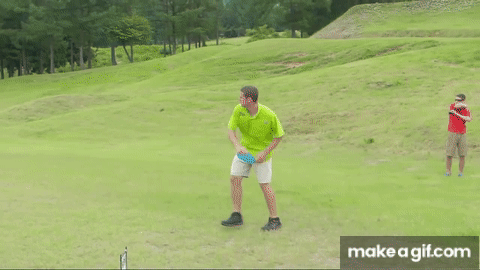That standstill is already somewhat slowed down from about 1:34 here. Good to watch it in real time too.
I can probably slow it down more on my desktop.
A few angles here including slow motion. Watch the first throw for the similar complex interaction between disc and hand. There is visible torque on disc coming into
and out of release. In contrast, GG and Jesper had torque coming into the release but (appear to be) low wobble when they come out. Puzzle: what's different about their whip cracks? What's the same?
Wiggins is a good example of someone who uses out-in-out pattern that becomes very "wide" in shorter shots, but very "narrow"/straighter back at full power, proportional to the size of his weight shift. Notice how the disc and body move relative to one another through the move and you start to get something about how the move works, including the arm path and grip dynamics, I reckon. Why does it matter that Wiggins looks like he could take a tackle or swing a ram in his standstill just as well as throw a Frisbee? This is the main lesson from posture theory, which also includes grips and their intents.
One of the reasons I still like watching players when their form was more raw, clunky, and sometimes violent is it contains lessons about how the move works overall. If you watch a baby learning to walk it is mostly a process of being out of balance and falling until the brain learns to predict and calibrate itself, then you get a phase transition that becomes what we call "walking." The arms are part of that process. Many people learning form in adulthood never explore the range that might make them fall down, which restricts their search and learning space. The same can happen to arm moves and grips as part of the overall move, I think. Just some fun neuromuscular lessons learned along the way.
Probably good reason to compare and test grip effects across tools, relate them to the overall move, psychological intent etc. in the long run.
Here's an example:
"pour the coffee" I've already made my joke about this.. cause nobody really pours anything that way except when your waiter is trying to be polite and not reach to far over your table. But holy crap. He pushes his wrist forward at one point... And the disc is like pointing so far down ...

www.dgcoursereview.com



